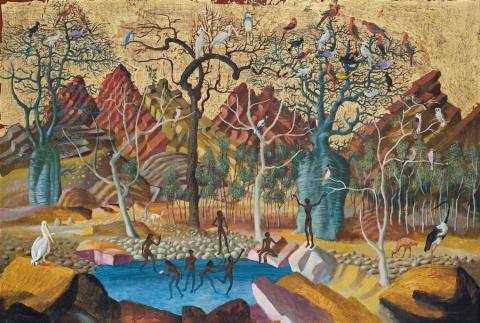AUSTRALIAN FANTASY, 1964
Donald Friend
oil and gold leaf on composition board
60.0 x 88.0 cm
signed lower right: DONALD FRIEND
Mr and Mrs R. Crebbin, Sydney
Private collection, Sydney
Martin Browne Fine Art, Sydney
Private collection, Sydney, acquired from the above in 1991
Donald Friend Retrospective, Art Gallery of New South Wales, Sydney, 9 February – 25 March 1990, touring to National Gallery of Victoria and Tasmanian Museum and Art Gallery (label attached verso)
20th Century Australian and New Zealand Painting, Martin Browne Fine Art, Sydney, 22 August – 28 September 1991, cat. 32 (illus. in exhibition catalogue)
The Art of Gold, Ballarat Art Gallery, Victoria, 28 November – 1 February 1998, cat. 54
Pearce, B., Donald Friend, 1915–1989, Retrospective, Art Gallery of New South Wales, Sydney, 1990, cat. 79, p. 101 (illus.)
The Art of Gold, Ballarat Fine Art Gallery, Victoria, 1998, p. 18, cat. 54
During 1964, Donald Friend completed a number of fascinating watercolours and sculptures of historical interest, focusing on the Trojan war. As a master of the exotic, this is not unexpected, with ancient Greeks and Trojans plumed in battle gear, horses inspired by decorations on shards of pottery, and lances so long that only those heroes of Homeric glory could handle. Developing the theme of the relationship between warriors and horses, Friend brought all to a climax in the copper sculpture, The Trojan Horse, 1964, in the collection of the National Gallery of Australia, Canberra. The lively and helmeted Greek heroes leap out of the horse's belly to sack Troy - the source of that well known saying to never trust a Greek bearing gifts! Friend also turned his attention to Australia and painted a brilliant series of history paintings devoted to the saga of the Aboriginal hero Bennelong. During the first years of white settlement at Sydney Cove, Bennelong and Governor Arthur Phillip developed a relationship that augured well for the future understanding between the two cultures. Bennelong, after whom Sydney's Bennelong Point is named, was one of those heroic yet tragic figures whose life metamorphosed into legend. Friend's ten painted panels featured gold leaf, as used by the European masters of old in their stories based on the Bible and saints. Friend used gold not only for its richly decorative appeal, but also to elevate his subject by association, raising the life of Bennelong to a level equivalent to that of the Christian saints and martyrs. He rightly regarded these paintings as among his most important. Fittingly, today they hang in the Sydney Opera House.
The much larger work, Australian Fantasy (Landscape), 1964, is related thematically in its legendary emphasis and allied use of gold. Ravishingly beautiful in its use of line and colour, and spectacular in its imaginative celebration of Australia and her indigenous peoples, the work provides an image of that golden age so loved by the ancient Greeks. It is the Christian equivalent of the Garden of Eden, bounteous and peaceful. The rainbow of colours associates it with what lies where it touches the earth, the rainbow being a symbol of reconciliation. The plenitude of bird life of exotic plumage, and the joyous gestures of the Aboriginal people echo the harmonious beauty of all life. Painted in the period between Friend's return to Australia from Sri Lanka in 1961 and his departure for Bali five years later, Australian Fantasy constitutes an apotheosis of Aboriginal Dreamtime in harmony with European lore and legend.
DAVID THOMAS
